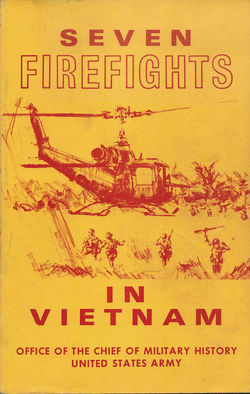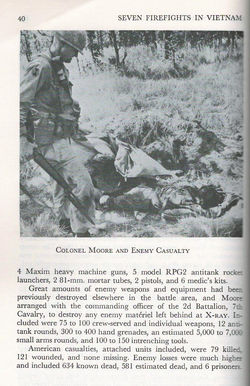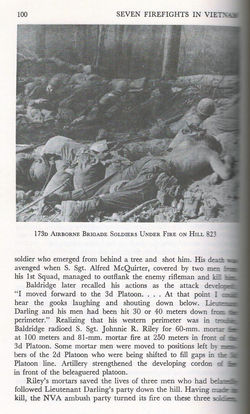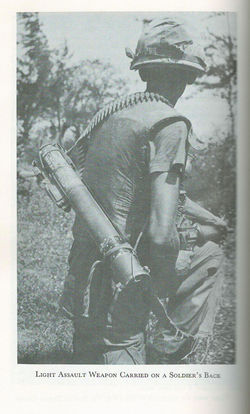SEVEN
FIREFIGHTS IN VIETNAM IA DRANG CONVOY AMBUSH PHUOC AN DAK TO LANG VEI US ARMY
US NAVY USMC
SOFTBOUND BOOK IN ENGLISH by
JOHN A. CASH, JOHN ALBRIGHT and ALLAN W. SANDSTRUM
FIGHT AT IA DRANG 14-16 NOVEMBER
1965 �WE WERE SOLDIERS ONCE�: the first major battle between the United States
Army and the People's Army of Vietnam (PAVN), as part of the Pleiku Campaign
conducted early in the Vietnam War, at the eastern foot of the Chu Pong Massif
in the central highlands of Vietnam, in 1965. It is notable for being the first
large scale helicopter air assault and also the first use of Boeing B-52
Stratofortress strategic bombers in a tactical support role. Ia Drang set the
blueprint for the Vietnam War with the Americans relying on air mobility, artillery
fire and close air support, while the PAVN neutralized that firepower by
quickly engaging American forces at very close range. Ia Drang comprised two
main engagements, centered on two helicopter landing zones (LZs), the first
known as LZ X-Ray, followed by LZ Albany, farther north in the Ia Drang Valley. LZ X-Ray involved the 1st Battalion, 7th
Cavalry Regiment and supporting units under the command of Lieutenant Colonel
Hal Moore, and took place November 14�16, at LZ X-Ray. Surrounded and under
heavy fire from a numerically superior force, the American forces were able to
drive back the North Vietnamese forces over three days, largely through the
support of air power and heavy artillery bombardment, which the North
Vietnamese lacked. The Americans claimed LZ X-Ray as a tactical victory, citing
a 10:1 kill ratio.
CONVOY AMBUSH ON HIGHWAY 1, 21
NOVEMBER 1966: When the 11th Armored Cavalry-the "Blackhorse
Regiment"- arrived in the Republic
of Vietnam in September 1966, the threat of ambush hung over every highway in the country. Since the
regiment's three squadrons each had a
company of main battle tanks, three armored cavalry troops, and a howitzer battery, the Blackhorse was well suited for
meeting the challenge. Each of the
cavalry troop's three platoons had nine armored cavalry assault vehicles (ACAV's). The ACAV was an M113
armored personnel carrier modified for
service in Vietnam and particularly adapted to convoy escort. With the M113's usual complement of one .50-caliber
machine gun augmented by two M60 machine
guns, all protected by armored gun shields, and with one of its five-man crew armed with a 40-mm. grenade launcher,
the vehicle took on some of the
characteristics of a light tank. Fast, the track-laying ACAV could keep
pace with wheeled vehicles and also
deliver withering fire. Aware that
convoy escort would be a primary mission of the 11th Cavalry, the regiment's
leaders had concentrated in the five months between alert and departure for
Vietnam on practicing counter ambush techniques. In countless mock ambushes,
the cavalrymen learned to react swiftly with fire. The first object was to run
thin-skinned vehicles out of the killing zone; the armored escorts would then
return to roll up the enemy's flanks, blasting with every weapon and crushing
the enemy beneath their tracks. In
mid-October, a month after arriving at a staging area at Long Binh, a few kilometers northeast of Saigon, the
regiment issued its first major operational
order. The Blackhorse was to establish a regimental base camp on more
than a square mile of ground along Interprovincial Highway 2, twelve
kilometers south of the provincial
capital of Xuan Loc.
AMBUSH AT PHUOC AN 18 JUNE 1967:
Before the mid- 1965 build-up of American troops in the Vietnam War, it could
be said with some degree of certainty that "the night belongs to the Viet
Cong." But as the American offensive operations mounted, the enemy could
no longer use darkness with impunity. On
any given night in Vietnam, American soldiers staged hundreds of ambushes, for
the ambush is one of the oldest and most effective military means of hampering
the enemy's nighttime exploits. Sometimes an ambush was used to provide
security for a defensive position or a base camp, sometimes simply to gain
information, and at other times to protect villages against enemy terrorists.
During the night of 18 June 1967, ten infantrymen of the U.S. 196th Light
Infantry Brigade set an ambush at a point sixteen kilometers south of Chu Lai,
in Quang Ngai Province, in the hope of waylaying enemy terrorists. As part of
Task Force OREGON, the brigade had been conducting offensive operations to
assure the security of the Chu Lai base complex. To this end, the 3d Battalion,
21st infantry, was sending out patrols from a battalion base of operations ten
kilometers south of Chu Lai and just north of the Song Tra Bong River, with the
specific mission during daylight hours of looking for possible mortar or rocket
sites that might pose a threat to the Chu Lai airstrip and at night of
establishing ambushes near locations of suspected enemy activity. To accomplish
its mission, the ad Battalion had divided its area of responsibility into
company sectors, assigning to Company A a sector that included two hamlets,
Phuoc An (1) and Phuoc An (2). When a week's search had uncovered no mortar or
rocket sites, the Company A commander decided to establish an ambush in the
vicinity of the two hamlets. One of his patrols had heard screams and unusual
commotion from one of the hamlets and, later, intelligence reports had
indicated that aggressive patrolling just might turn up
FIGHT ALONG THE RACH BA RAI
RIVER, 15 SEPTEMBER 1967: The murmur of voices and the scrape of weapons
against the sides of the steel ship penetrated the damp night as the men of the
3d Battalion, 60th Infantry, climbed from a barracks ship, the USS Colleton,
and into waiting landing craft alongside. It was 0300, 15 September 1967.
Within minutes after boarding the boats, most men slept. Late the previous day
they had come back from a three-day operation during which, in one sharp,
daylong battle, nine of their comrades had fallen, along with sixty of the enemy.
There had been time during the night to clean weapons, shower, eat a hot meal,
and receive the new operations order, but not much time to sleep off the now
familiar weariness that engulfed these infantrymen after days of fighting both
the Viet Cong and the mud of the Mekong Delta.
Three days before Col. Bert A. David's Mobile Riverine Brigade, the 2d
Brigade of the 9th Infantry Division, and its Navy counterpart, Task Force 117,
had set out to search for and destroy the 514th Local Force and 263d Main Force
Viet Cong Battalions. When the enemy was finally found, the ensuing battle had
only weakened, not destroyed, the Viet Cong battalions, which broke off the
fight and slipped away. Thus, when
intelligence reports that reached the Riverine Brigade's headquarters on the
afternoon of 14 September placed the Viet Cong in the Cam Son Secret Zone along
the Rach Ba Rai River, Colonel David resolved to attack. (See Map 1) Quickly he
pulled his units back from the field and into their bases to prepare for a
jump-off the next morning. For the 3d Battalion, 60th Infantry, that meant a
return to the USS Colleton, anchored in the wide Mekong River near the Mobile
Riverine Force's base camp at Dong Tam. The 263d Main Force Viet Cong Battalion
attacks a Mobile Riverine Force convoy on the Rach Ba Rai River, in the Mekong
Delta. The American force is comprised of a U.S. Army Mobile Riverine brigade
and elements of Navy Task Force 117. When the U.S. convoy rounds a bend in the
river, the Viet Cong attack with rockets, recoilless rifles, and small arms.
They hit 21 boats and kill 7 American servicemen while wounding 123 men. Many
of the casualties are Navy Sailors from Task Force 117, making it one of the Navy�s
costliest riverine actions to date. The majority of the Viet Cong battalion
slips away during the night, leaving behind 79 dead.
THREE COMPANIES AT DAK TO, 6
NOVEMBER 1967: In early February 1954, French Union forces were drawn into the
final, convulsive combat actions of the Indochina War. A closing act of that
drama took place on 2 February when the Viet Minh launched simultaneous attacks
in battalion strength that overwhelmed all French outposts northwest of Kontum
City. By 7 February the French high command, realizing that its tenuous hold on
Kontum Province had been broken, evacuated the provincial capital. The ejection
of French forces from this key province in the Central Highlands marked a giant
step in the march of Communist insurgency.
Thirteen years later, reconstituted Communist forces readied another
major effort in Kontum Province. Although the stage was the same, the cast and
scale of confrontation were somewhat different. This time regular units of the
North Vietnamese Army (NVA) prepared to strike a telling blow against South
Vietnamese and U.S. Military Assistance Command forces. The North Vietnamese
Army objective was not to reduce all Free World outposts in Kontum, but to
chalk up a sorely needed victory by seizing just one- the Dak To complex-a few
kilometers from a key French post of the same name that was overrun in 1954. Dak To was one of a chain of Civilian
Irregular Defense Group (CIDG) camps advised by U.S. Special Forces personnel.
Situated in the west central part of Kontum Province, it could be reached from
Pleiku City by following Route 14 north through Kontum City and then turning
west on Route 512. North of Dak To, Route 14 rapidly deteriorated as it
approached a CIDG camp at Dak Seang. Still farther to the north the road became
so poor that another camp at Dak Pek had to rely solely on an aerial life line.
BATTLE OF LANG VEI, 7 FEBRUARY
1968: The Battle of Lang Vei (Vietnamese: Trận L�ng V�y) began on the evening
of 6 February 1968 and concluded during the early hours of 7 February, in Quảng
Trị Province, South Vietnam. Towards the end of 1967, the 198th Tank Battalion
of the People's Army of Vietnam's (PAVN) 202nd Armored Regiment received
instructions from the North Vietnamese Ministry of Defense to reinforce the
304th Division as part of the Route 9�Khe Sanh Campaign. After an arduous
journey down the Ho Chi Minh trail in January 1968, the 198th Tank Battalion
linked up with the 304th Division for an offensive along Highway 9, which
stretched from the Laotian border through to Quảng Trị Province. On 23 January,
the 24th Regiment attacked the small Laotian outpost at Bane Houei Sane, under
the control of the Royal Laos Army BV-33 "Elephant" Battalion. In
that battle, the 198th Tank Battalion failed to reach the battle on time because
its crews struggled to navigate their tanks through the rough local terrain.
However, as soon as the PT-76 tanks of the 198th Tank Battalion turned up at
Bane Houei Sane, the Laotian soldiers and their families retreated into South
Vietnam. After Bane Houei Sane was
captured, the 24th Regiment prepared for another attack which targeted the U.S.
Special Forces Camp at Lang Vei, manned by Detachment A-101 of the 5th Special
Forces Group and indigenous Civilian Irregular Defense Group (CIDG) forces. On
6 February, the 24th Regiment, again supported by the 198th Tank Battalion,
launched their assault on Lang Vei. Despite artillery and air support, the
U.S.-led forces conceded ground and the PAVN quickly dominated their positions.
By the early hours of 7 February the command bunker was the only position still
held by Allied forces. To rescue the American survivors inside the Lang Vei
Camp, a counterattack was mounted, but the Laotian soldiers who formed the bulk
of the attack formation refused to fight the PAVN. Later on, U.S. Special
Forces personnel were able to escape from the camp and were rescued by a U.S.
Marine task force from Khe Sanh Combat Base.
GUNSHIP MISSION, 5 MAY 1968: By
mid-1966 gun helicopter platoons, each platoon consisting of eight UH-1 (Huey)
helicopters armed with rockets and machine guns and each platoon organic to an
assault helicopter company, were hard at work all over South Vietnam. Usually
five of the Hueys in a platoon were kept ready at all times while the other
three were held in reserve or were undergoing maintenance. Four of the ready
gunships flew in pairs, designated light fire teams. The fifth could be used to
augment the fire of either team, and when so employed the three ships
constituted a heavy fire team. Operating in support of American, South
Vietnamese, and allied forces, these fire teams had a hazardous assignment, for
the relatively slow-moving helicopter, flying at low levels, is highly vulnerable
to ground fire. So valuable was the ships' support to ground troops, however,
that the risks were considered justifiable. In the spring of 1968 an incident
occurred on the outskirts of Saigon, the South Vietnamese capital, that
illustrates some of the methods used by the fire teams. The strong offensive launched by the North
Vietnamese and the Viet Cong during the Tet holiday had ended, but intelligence
sources indicated the possibility of a follow-up assault against the capital.
During late April and the first few days of May, substantial enemy forces were
reported moving closer to Saigon from three directions. To meet the enemy threat, Maj. Gen. Le Nguyen
Khang, the South Vietnamese Army commander responsible for the defense of the
city, relocated his forces, which normally operated in the outlying areas
surrounding Saigon, to form a defensive ring closer to the city. As a part of
the new deployment, he installed the three battalions of the South Vietnamese
5th Ranger Group on the edge of the Cholon sector in southwestern Saigon.
General Khang charged his units with locating enemy caches, preventing
infiltration of men, weapons, ammunition, and equipment, and destroying any
enemy forces that might manage to slip in.
The 5th Ranger Group, to carry out this order, placed two companies of
its 30th Ranger Battalion in approximately thirty ambush positions along a
north-south line a few kilometers west of the Phu Tho Racetrack, in the center
of the Cholon sector, with another company behind them as a blocking force. A
fourth company continued to perform security duties at the battalion base camp,
eight kilometers away. In addition to
reinforcements available from II Field Force and Vietnamese III Corps
headquarters and on-call artillery arid air strikes, General Khang's units
could ask for assistance from the gunships of the 120th Aviation Company
(Airmobile, Light). At that point in the Vietnam fighting, the 120th Aviation
Company was not engaged in the combat assaults usually performed by such units
but was assigned to provide administrative transportation for headquarters of
the Military Assistance Command, Vietnam (MACV), and headquarters of the United
States Army, Vietnam (USARV). In April 1968, however, MACV headquarters had
directed that four armed helicopters of the company's gunship platoon be made
available to Capital Military District headquarters to provide fire support for
ground troops in and around Saigon. One fire team was to be on 5-minute alert
status on the Air Force flight line at Tan Son Nhut Air Base while the other
was to be on 30-minute standby at the gunship platoon headquarters on the Tan
Son Nhut Air Base helipad. These gunships of the 120th Aviation Company were
later to become heavily involved in the defense of Saigon against a major enemy
attack. Before dawn on 5 May 1968 the
enemy offensive erupted. A battalion of a main force Viet Cong regiment with an
estimated strength of 300 men attacked the Newport Bridge and adjacent docking
facilities along the waterfront in northeastern Saigon. The fight was joined.









